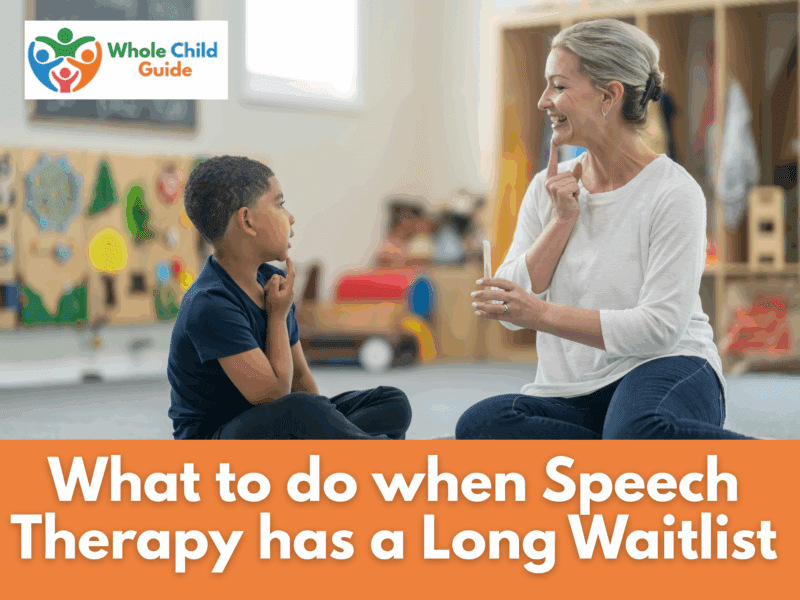
If you’re typing speech therapy near me or speech therapist near me into a search bar, you might be wondering if your child really needs speech support, or if they’ll “just grow out of it.” The truth is, pediatric speech therapy near me covers much more than pronunciation. Speech-language pathologists (SLPs) support communication, social skills, feeding, and confidence. Sometimes that extensive list means that your child is placed on a waitlist and can’t get into the clinic for weeks or months.
The issue that we see is that the therapy providers near you may not be specialized in the areas you are looking for. Then there is the waitlist issue. You might need to wait months to even get into the office for an evaluation. We’ll cover more about these concerns in this article. We also want to take a whole child view of speech therapy services when you are looking at local therapy clinics.
A whole child approach means looking at how communication connects to learning, friendships, emotions, and family life, not just how a child says their sounds. Also be sure to check out our guide on finding a physical therapist near me, because we offer lots of ideas there as well.

Plus, check out our ideas below to help when there is a long waitlist for speech therapy services.
What Speech Therapy Is (With a Whole Child Lens)
A speech therapist works on every part of communication: how kids understand language, express ideas, use social skills, and even safely eat and drink. They don’t just teach words, they help children participate fully in life.
- Body systems: oral motor strength, breathing, swallowing, auditory processing.
- Function: vocabulary, grammar, storytelling, social interactions, classroom communication, feeding skills.
- Participation: raising a hand in class, joining games on the playground, expressing feelings to family.
- Teamwork: SLPs collaborate with pediatricians, OTs, PTs, counselors, and teachers to build communication skills that matter everywhere.
Signs Your Child May Benefit from Speech Therapy Near Me
Wondering if it’s time to schedule a speech therapy evaluation can feel overwhelming for parents. Some children are simply “late talkers,” while others may need extra support to build strong communication skills.
A key thing to remember is that speech and language development is about more than just how clearly a child pronounces words. It includes how they understand directions, express ideas, connect socially, and even how they eat and swallow. If you’ve ever caught yourself comparing your child’s speech to siblings, classmates, or milestone charts, you’re not alone. Seeking an evaluation doesn’t mean something is “wrong.” It simply opens the door to better understanding your child’s strengths, areas for growth, and whether professional support could help.
It’s not always obvious when to call. Parents often seek out an SLP for these concerns:
- Infants & toddlers: few words by age 2, trouble imitating sounds, not pointing or gesturing, difficulty chewing or swallowing.
- Preschoolers: unclear speech, frustration when others don’t understand, stuttering, trouble with play-based social skills.
- School-age kids: struggles with reading comprehension, following directions, using complete sentences, making friends due to communication barriers.
- Tweens & teens: ongoing stuttering, voice concerns (frequent hoarseness), limited vocabulary, difficulty expressing complex thoughts, social anxiety tied to communication.
Parents also ask about feeding and swallowing, which is an area many don’t realize SLPs cover. Difficulty moving to solid foods, gagging, or picky eating with texture issues may also signal the need for therapy.
Diagnoses & Needs Speech Therapy Supports
While every child develops at their own pace, there are some red flags that suggest it may be time to seek extra support. These can look different depending on your child’s age. Speech therapy can work with any age, from a toddler who isn’t using words yet, to a preschooler who gets frustrated when others can’t understand them, to a school-age child who struggles to follow directions or keep up with classroom conversations.
From a whole child perspective, these challenges don’t exist in isolation. Difficulty with communication can affect friendships, confidence, learning, and even family routines like mealtimes. That’s why speech therapists look at the bigger picture and consider how speech and language connect with social skills, academics, emotions, and physical development. Below are some of the common diagnoses and areas that speech therapy providers support.
Here is an article explaining what to look for in a speech therapy provider.
- Speech sound disorders (articulation, phonological delays)
- Language delays and disorders
- Stuttering and fluency disorders
- Childhood apraxia of speech
- Autism spectrum disorder (social communication and language)
- ADHD (organization of language, social skills)
- Learning disabilities (reading, writing, comprehension)
- Voice disorders (hoarseness, pitch, vocal strain)
- Feeding and swallowing challenges
- Developmental delays and genetic syndromes (Down syndrome, cerebral palsy, etc.)
What A Speech Evaluation And Sessions Look Like
When you bring your child for a speech therapy evaluation, the process is designed to feel supportive, not intimidating. The goal is to understand the whole child, including how they communicate, interact, and participate in daily life.
During the evaluation, you can expect:
- Parent interview and history: The speech therapist will ask about your child’s development, health, routines, and your concerns. Parents know their child best, so your insight is essential.
- Play-based or structured assessment: For younger children, the evaluation may look like play with blocks, books, puppets, or pretend games. While they play, the therapist observes communication, attention, and interaction. For older children, more structured tasks might be used, such as answering questions, retelling a story, or following directions.
- Speech and language skills check: This may include listening for sound errors, checking vocabulary and grammar, observing conversation skills, or screening feeding/swallowing if that’s a concern.
- Whole child perspective: The therapist also considers how factors like attention, sensory needs, anxiety, or motor skills might be affecting communication.
- Clear feedback: Before you leave, you’ll get an explanation of what was observed, whether therapy is recommended, and practical strategies to try at home.
What treatment sessions look like:
- Play with purpose: Therapy for kids is active and engaging; think games, songs, crafts, and role-play that sneak in practice opportunities.
- Skill-building in context: Speech sounds might be practiced while playing a board game, or social skills while building with Legos. For older kids, activities may include reading passages, writing stories, or practicing conversations.
- Family involvement: Parents often observe or participate so strategies can be carried over into home and school routines.
- Collaboration with the team: SLPs share updates with teachers, pediatricians, OTs, PTs, and counselors as needed so that progress supports the whole child.
- Home practice: Each session typically ends with a short, practical “home program”. This might be easy activities you can embed in daily life, like practicing target sounds during toothbrushing or using conversation starters at dinner.
Speech therapy isn’t a one-size-fits-all process. Each evaluation and session is individualized, but the heart of therapy is always the same: helping your child find their voice, connect with others, and thrive across all areas of development.
Whole Child Collaboration In Action
Communication doesn’t develop in a vacuum. It touches every part of a child’s daily life. That’s why speech therapy often works best when paired with other supports that see the whole child. Collaboration might include your pediatrician, teachers, or other therapists, but it can also extend to less traditional services like parent coaching, feeding workshops, or sports-readiness programs offered by local providers.
These out-of-the-box options give families extra tools and strategies to use at home, in school, and in the community, making therapy more effective and everyday life smoother. By thinking beyond the single therapy session, families get a network of support that truly meets their child where they are.
- Pediatrician: developmental screenings, referrals, and medical rule-outs.
- OT: sensory integration and oral motor strength that impact feeding and speech.
- PT: posture and breath support for speech production.
- Teacher: classroom carryover, reading and writing integration.
- Counselor: self-confidence, anxiety reduction, and social skill support.
What Parents Can Try At Home While You Wait
One of the hardest parts of seeking speech therapy is the waiting. Many families face long waitlists for evaluations or clinic sessions, and it can feel frustrating to know your child needs support but not be able to start right away. The good news is there are meaningful things you can do at home during this time. Small, everyday routines can make a big difference in building communication, confidence, and connection. From encouraging play-based social skills, to weaving in language through mealtimes and feeding experiences (learn how feeding supports the whole child), you don’t have to wait to get started. These ideas aren’t a replacement for therapy, but they give your child a strong foundation while you prepare for the next step.
While therapy is best guided by an SLP, you can build communication-rich routines now:
- Read aloud daily and pause for your child to comment or predict.
- Use simple routines (“first, then”) to support understanding.
- Model clear speech and repeat your child’s words correctly without pressure.
- Play games that require turn-taking and conversation.
- Encourage storytelling at dinner (“What was the funniest thing today?”).
How To Choose The Right Speech Therapist Near Me
When looking for a clinic in our directory, consider:
- Pediatric experience and specialty with your child’s age group.
- Experience in your specific concern (e.g., apraxia, stuttering, feeding).
- Approach: play-based, evidence-based, and family-centered.
- Ability to collaborate with your pediatrician, school, and other therapists.
- Options for individual sessions, group therapy, or parent coaching.
FAQs
Is speech therapy only for kids who can’t say their sounds?
No. It covers understanding, expression, social communication, and feeding as well.
Can I see a speech therapist without a referral?
In many cases, yes. Insurance requirements vary, but you can often schedule directly.
How long does therapy take?
It depends on the child’s needs, goals, and consistency with practice. Some children make progress quickly, others need ongoing support.
Can speech therapy help with reading and writing?
Yes. Language underlies literacy, and SLPs often address comprehension, vocabulary, and narrative skills.
Ready To Find Help?
You don’t have to wonder if your child will “catch up.” Speech therapy can make a life-changing difference in communication, confidence, and connection. Search the Whole Child Guide directory to find speech therapy near me and connect with professionals who look at the whole child.
Are you a Speech Therapist?
List your clinic (insurance or cash-based services) or cash-based workshops, coaching, or tutoring services in our directory. We are building out something special and want you to be a part of it!
